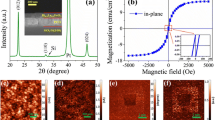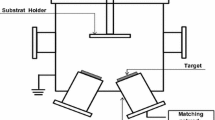Abstract
A BiFeO3 thin-film was prepared from a solution by deposition on a Pt/TiO2/SiO2/Si substrate via a spin coating process and was subsequently annealed at 300 °C for 1 h to afford a non-crystallized BiFeO3 thin-film. Locally crystallized BiFeO3 nanodots were formed in the non-crystallized BiFeO3 thin-film via a local crystallization process using an atomic force microscope tip heated to 550 °C. By controlling the local heating time, ferroelectric BiFeO3 nanodots with different diameters ranging from 65 to 120 nm were obtained. The ferroelectric properties of the BiFeO3 nanodots were further investigated by studying the local ferroelectric switching behaviors and local piezoelectric d33 hysteresis loops using a piezoresponse force microscope.





Similar content being viewed by others
References
Ghoneim MT, Hussain MM (2015) Study of harsh environment operation of flexible ferroelectric memory integrated with PZT and silicon fabric. Appl Phys Lett 107:052904
Kim W-H, Son JY, Shin Y-H, Jang HM (2014) Imprint control of nonvolatile shape memory with asymmetric ferroelectric multilayers. Chem Mat 26:6911–6914
Lipatov A, Sharma P, Gruverman A, Sinitskii A (2015) Optoelectrical molybdenum disulfide (MoS2) ferroelectric memories. ACS Nano 9:8089–8098
Scott JF (2007) Applications of modern ferroelectrics. Science 315:954–959
Son JY, Ryu S, Park Y-C, Lim Y-T, Shin Y-S, Shin Y-H, Jang HM (2010) A nonvolatile memory device made of a ferroelectric polymer gate nanodot and a single-walled carbon nanotube. ACS Nano 4:7315–7320
Dussan S, Kumar A, Scott JF, Priya S, Katiyar RS (2010) Room temperature multiferroic effects in superlattice nanocapacitors. Appl Phys Lett 97:252902
Lee W, Han H, Lotnyk A, Schubert MA, Senz S, Alexe M, Hesse D, Baik S, Gosele U (2008) Individually addressable epitaxial ferroelectric nanocapacitor arrays with near Tb inch-2 density. Nat Nano 3:402–407
Son JY, Lee J-H, Song S, Shin Y-H, Jang HM (2013) Four-states multiferroic memory embodied using Mn-doped BaTiO3 nanorods. ACS Nano 7:5522–5529
Chu M-W, Szafraniak I, Scholz R, Harnagea C, Hesse D, Alexe M, Gosele U (2004) Impact of misfit dislocations on the polarization instability of epitaxial nanostructured ferroelectric perovskites. Nat Mater 3:87–90
Jung I, Son JY (2012) A nonvolatile memory device made of a graphene nanoribbon and a multiferroic BiFeO3 gate dielectric layer. Carbon N Y 50:3854–3858
Jia C-L, Nagarajan V, He J-Q, Houben L, Zhao T, Ramesh R, Urban K, Waser R (2007) Unit-cell scale mapping of ferroelectricity and tetragonality in epitaxial ultrathin ferroelectric films. Nat Mater 6:64–69
Seyidov MY, Coskun E, Sahin Y, Khamoev R, Suleymanov RA (2006) The effect of thermal annealing on impurity states in ferroelectric- semiconductor TlGaSe2 within the incommensurate phase. Semicond Sci Technol 21:171–174
Hyuk Park M, Joon Kim H, Jin Kim Y, Lee W, Moon T, Seong Hwang C (2013) Evolution of phases and ferroelectric properties of thin Hf 0.5Zr0.5O2 films according to the thickness and annealing temperature. Appl Phys Lett 102:242905
Hironori F, Yuko M, Masaru S (2006) Fabrication of self-assembled Au nanodots and their applications to ferroelectric nanocapacitors. Jpn J Appl Phys 45:7262–7264
Yoo H, Bae C, Kim M, Hong S, No K, Kim Y, Shin H (2013) Visualization of three dimensional domain structures in ferroelectric PbTiO3 nanotubes. Appl Phys Lett 103:022902
Piner RD, Zhu J, Xu F, Hong S, Mirkin CA (1999) ‘Dip-pen’ nanolithography. Science 283:661–663
Hyun J, Ahn SJ, Lee WK, Chilkoti A, Zauscher S (2002) Molecular recognition-mediated fabrication of protein nanostructures by dip-pen lithography. Nano Lett 2:1203–1207
Wang Y, Jiang QH, He HC, Nan CW (2006) Multiferroic BiFeO3 thin films prepared via a simple sol-gel method. Appl Phys Lett 88:142503–142501
Seo J, Ahn Y, Kim W-H, Son JY (2016) Local ferroelectric responses of epitaxial PbTiO3 thin films to heated atomic force microscopy. Mater Lett 168:134–137
Yang J-K, Kim WS, Park H-H (2001) Effect of grain size of Pb(Zr0.4Ti0.6)O3 sol-gel derived thin films on the ferroelectric properties. Appl Surf Sci 169(70):544–548
Qiao L, Bi X (2009) Microstructure and grain size dependence of ferroelectric properties of BaTiO3 thin films on LaNiO3 buffered Si. J Eur Ceram Soc 29:1995–2001
Kim W-H, Son JY (2013) The effects of La substitution on ferroelectric domain structure and multiferroic properties of epitaxially grown BiFeO3 thin films. Appl Phys Lett 103:132907
Bark CW, Ryu S, Koo YM, Jang HM, Youn HS (2007) Electric-field-induced structural modulation of epitaxial BiFeO3 multiferroic thin films as studied using x-ray microdiffraction. Appl Phys Lett 90:022902
Acknowledgements
This work was supported by the Korea Research Foundation Grant under contract no. 2015R1A2A2A05027951.
Author information
Authors and Affiliations
Corresponding author
Ethics declarations
Conflict of interest
The authors declare that they have no conflict of interest.
Additional information
Highlights
-
Locally crystallized BiFeO3 nanodots were formed in a non-crystallized BiFeO3 thin-film via a local crystallization process using an atomic force microscope tip heated to 550 °C.
Rights and permissions
About this article
Cite this article
Shin, H.W., Son, J.Y. Ferroelectric BiFeO3 nanodots formed in non-crystallized BiFeO3 thin-films via a local heating process using a heated atomic force microscope tip. J Sol-Gel Sci Technol 86, 170–174 (2018). https://doi.org/10.1007/s10971-018-4627-9
Received:
Accepted:
Published:
Issue Date:
DOI: https://doi.org/10.1007/s10971-018-4627-9




